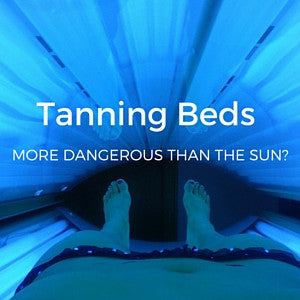
Tanning Beds vs Sun: Are Tanning Beds Bad For You?

Photo: Alexis O’Toole on Flickr
Almost 30 million people tan indoors in the United States every year. That’s a lot. Many indoor tanning companies will tell you that lying in a tanning bed is actually safer for your skin than being in the sun. Other people insist you’re better off lying on the beach.
So which is it? Are tanning beds bad for you? And is a tanning bed really worse than the sun?
It’s more complicated than you might expect. To understand the truth about tanning beds, we need to look at the science behind tanning and what it really does to your skin.
But first let’s look at how tanning became so popular in the first place.
A Brief History of Tanning
Rumor has it Coco Chanel first popularized the tan when she returned from the French Riviera after getting a little too much sun.
People started copying the look, and tanning became a new fashion trend.
By the 1970s, two things had happened. First, dermatologists started speaking out about the dangers of tanning and urged people to wear sunscreen. Second, tanning beds were created, claiming to be an alternative for people who wanted a tan without the damaging effects of the sun.
But dermatologists didn’t buy it. Many said tanning beds were even worse than the sun.
That gave some people cause for concern, but most didn’t really understand how tanning worked, or how it damaged their skin.
How Does Tanning Work?
Ready for a quick lesson on how sunlight interacts with our skin to produce a tan?
The pigment of your skin is determined by the amount of melanin produced by your skin cells. How much melanin your cells produce depends on your race and genetic make up, but it also depends on how much sunlight your skin is exposed to.
Have you ever heard that dark clothing absorbs more heat from the sun than light clothing? (That’s why white is a popular summer color.) It’s the same idea with tanning.
When ultraviolet light touches your skin, your cells start producing more melanin, making your skin darker. That extra melanin protects your cells by absorbing radiation from the sun.
That brings me to my next point. It’s not visible sunlight that damages your skin and causes you to tan, it’s ultraviolet radiation (UV).

Sunlight hits us here on Earth in three forms: visible light, infrared (heat), and ultraviolet. Two types of ultraviolet light make it through the Earth’s atmosphere to reach us. UVA and UVB.
Until recently, the popular belief was that UVA caused tanning, whereas UVB was responsible for sunburns and therefore also skin damage like aging, wrinkles, and skin cancer.
Unfortunately, newer research implicates UVA too. Since 95 percent of the radiation that actually gets to the Earth’s surface is UVA, that poses a problem.
Why Not Tan?
If tanning is our body’s natural sun protection, why not have one all the time? That’s the logic behind base tans. Unfortunately, a tan only provides protection of SPF 3 or less. That’s almost no protection at all.
Plus, if you have a tan, that means your skin has already been damaged. Our bodies are amazing, but they can’t protect us like sunscreen and a good old fashioned sun hat!

Now, what about tanning beds vs sun?
How Are Tanning Beds Different From the Sun?
Tanning beds use fluorescent bulbs that release UVA and a smaller amount of UVB. They do this to mimic the effects of sunlight, resulting in a more natural looking tan.
But tanning beds damage your skin just like the sun does. It doesn’t matter where it’s from. UV radiation is dangerous for your skin. What matters is the intensity of the radiation. In fact some tanning beds emit UVA that is 3 times more intense than natural sunlight!
A recent study found tanning beds to be twice as dangerous as the midday Mediterranean sun. And the World Health Organization says they are as damaging as cigarettes when it comes to cancer risk.
That’s probably why places like Brazil and New South Wales, Australia have completely banned the use of tanning beds, and many other places have outlawed them for minors.
So, in general, tanning beds are worse for you than the sun, but both damage your skin.
Staying far away from the tanning salon is the first step, but there’s a lot more you can do to protect yourself.
Protect Your Skin
The best thing you can do for your skin is embrace your natural skin tone and not tan at all! Healthy skin is beautiful and won’t show as many signs of aging. Or, if you really want that bronzed look, get an artificial spray tan before your next trip to the beach.
That’s another important point. Protecting your skin doesn’t mean living in a cave. You can still get out there and enjoy the sun. It’s all about being prepared.

Take sunscreen with you and reapply frequently. Consider bringing a sun umbrella if you’re heading to the beach. And make sure you have the right clothes and accessories. Sunglasses are a must, and you can never underestimate the power of UPF sun protective clothing, which blocks UV rays that regular fabrics don’t.
Want more content like this? Sign up for our newsletter for great skincare tips and sun savvy tricks!
